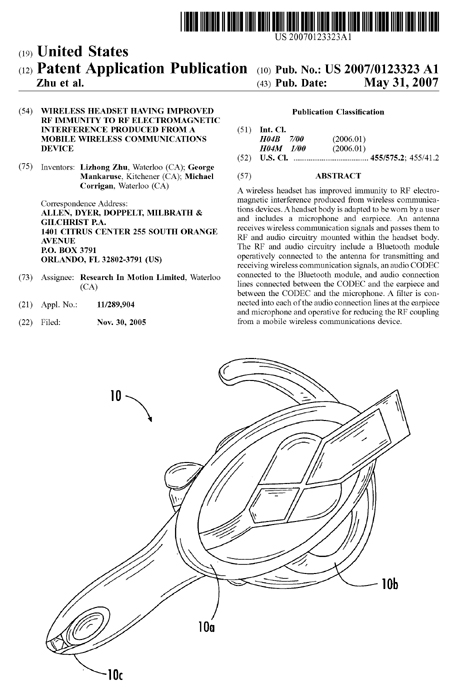BlackBerry patent app describes Bluetooth headsets with less interference vulnerability

A newly published BlackBerry Patent application calls for a Bluetooth headset with less vulnerability to RF electromagnetic interference.
The Patent app is entitled: Wireless headset having improved RF immunity to RF electromagnetic interference produced from a mobile wireless communications device.
A read of the Abstract gets us in the ballpark in terms of understanding what is being proposed here:
A wireless headset has improved immunity to RF electromagnetic interference produced from wireless communications devices. A headset body is adapted to be worn by a user and includes a microphone and earpiece.
An antenna receives wireless communication signals and passes them to RF and audio circuitry mounted within the headset body. The RF and audio circuitry include a Bluetooth module operatively connected to the antenna for transmitting and receiving wireless communication signals, an audio CODEC connected to the Bluetooth module, and audio connection lines connected between the CODEC and the earpiece and between the CODEC and the microphone.
A filter is connected into each of the audio connection lines at the earpiece and microphone and operative for reducing the RF coupling from a mobile wireless communications device.
Now, let me show you two diagrams from the Application, and underscore these with explanatory text.
The RF filters as described could be RF ferrite beads, serially connected inductors, or shunt capacitors or a combination of both. In another aspect, an isolation RF shield as a metallic formed enclosure or "can" could surround and isolate the microphone or earpiece transducer from radiating energy depending on the design. The solid line 12a, 14a in FIGS. 3 and 4 represents the "can" that could be used.
Different types, sizes and shapes of ferrite beads can be used. Typically, a ferrite bead is formed from a material having a permeability controlled by the composition of the different oxides, for example, a ferric oxide, sometimes with nickel and zinc added. The ferrite beads can sometimes be formed as ferrite sleeves with two half parts that are added onto a signal line or a solder overcoat on a signal trace. Typically, the longer the bead, the better the RF suppression. The bead equivalent circuit can be a series resistor and inductor.
Many of the components as described can be formed as an integrated circuit and contained within the headset body. The components can be mounted on a dielectric substrate, i.e., a circuit board. A circuit board could refer to any dielectric substrate, PCB, ceramic substrate or other circuit carrying structures for carrying signal circuits in electronic components. The battery 36 would typically be included within any headset housing for the Bluetooth headset. Ferrite beads or similar inductor components can also be used with modifications.
